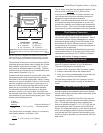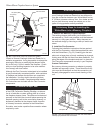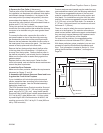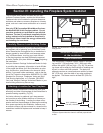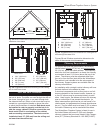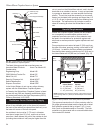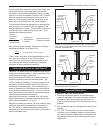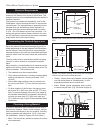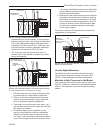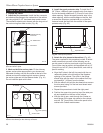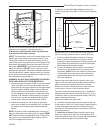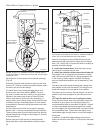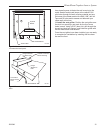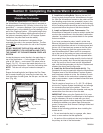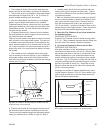
26
WinterWarm Fireplace Insert or System
2000941
Electrical Requirements
The WinterWarm Cabinet has a removable junction box
located on the bottom front corner of the left side. This
enables the wiring to be completed before the cabinet is
installed if desired.
The junction box houses two receptacles, one for the
WinterWarm column fans and the other for the optional
cabinet blower. The cabinet blower is especially recom-
mended when the WinterWarm will be installed in a
confined area that requires additional heat circulation.
A 115V, 15 or 20A electric service line is required. If in-
stalling the optional cabinet blower, decide on the loca-
tion for the blower control switch and mount a standard
single-switch box to the chase framing.
Customizing the Finished Appearance
The Trim Panels supplied with the WinterWarm System
fasten the cabinet to the chase framing and give a fin-
ished appearance to the gap between the WinterWarm
and the cabinet. They also provide a noncombustible
transition surface to join with the combustible wall finish
material, which must not extend inside the combustible
limits.
The trim panels may be used without additional facing
material, or with a surface to complement a specific
decor.
Many attractive, noncombustible finish materials can be
applied over the trim panels, including veneer brick, tile,
stone and plaster. The limitations are:
• The materials must be noncombustible.
• Their maximum thickness, including noncombustible
backing and adhesive, should not exceed 13/16”
(20 mm).
• Combustible edge molding must not protrude into
the room more than 2” (51 mm) from the panel sur-
face.
• To allow insertion of the fire box, the opening must
be at least 33¹⁄₄" (845 mm) wide, and 29" (737 mm)
high. To ensure coverage of the trim inner edges by
the installed WinterWarm fire chamber, the opening
must be not more than 35¹⁄₄" (895 mm) wide, and
33¹⁄₄" (845 mm) high. Figure 25 demonstrates these
dimensions.
Choosing a Facing Material
A variety of alternative facing materials can be used to
enhance the fireplace. Bear in mind, however, that the
total maximum thickness of any trim material, including
backing materials and adhesive is 13/16”. Here are a
few possibilities: (Refer to Figures 34-39 for detail.)
• Basic. The trim pieces, painted as desired, but other-
wise unadorned.
37³⁄₈"
(949mm)
FP11111
WinterWArm
wall finish material limits
4/5/01 djt
40³⁄₈" (1025mm)
Combustible
Limits
Notch for
Power Cord
FP1111
Fig. 34 Keep combustible wall finish materials outside these
limits.
29"
(737mm)
FP1112
WinterWArm
Min/Max wall facings
4/5/01 djt
33" (845mm)
33"
(845mm)
35" (895mm)
FP1112
Fig. 25 The fireplace opening must conceal the inner edges
of the trim as well as accomodate the insert.
• Plaster. A finish skim coat of plaster may be applied
over tile backer board or Wonderboard
®
, or over
expanded metal lath and a scratch coat.
• Stone. Marble, granite, soapstone, slate, or other
cut stone may be used. (Fig. 38) Stone may be ce-
FP1113
WW
basic trim
4/5/01 djt
Trim Piece
“J”
Bead
WinterWarm
Cabinet
FP1113
Fig. 36 Top view of basic metal trim.




